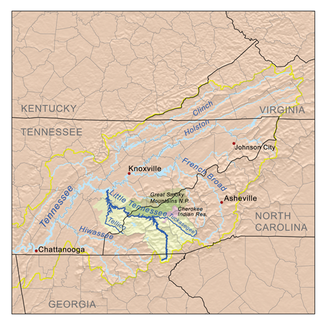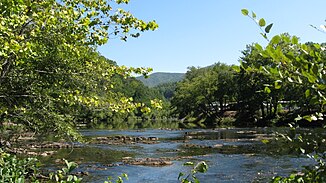Tuckasegee River
|
Tuckasegee River Tuckaseegee, Tuckaseigee |
||
|
Drainage basin of the Little Tennessee River |
||
| Data | ||
| Water code | US : 1016248 | |
| location | North Carolina (USA) | |
| River system | Mississippi River | |
| Drain over | Little Tennessee River → Tennessee River → Ohio River → Mississippi River → Gulf of Mexico | |
| Confluence of | Panthertown and Greenland Creeks 35 ° 10 ′ 6 ″ N , 83 ° 0 ′ 42 ″ W |
|
| muzzle |
Fontana Lake Coordinates: 35 ° 26 ′ 5 " N , 83 ° 35 ′ 5" W 35 ° 26 ′ 5 " N , 83 ° 35 ′ 5" W. |
|
| Mouth height |
520 m
|
|
| length | 37 km | |
| Left tributaries | West Fork Tuckasegee River , Savannah Creek , Barkers Creek , Connelley Creek , Kirkland Creek | |
| Right tributaries | West Fork Tuckasegee River , Savannah Creek , Barkers Creek , Connelley Creek , Kirkland Creek | |
|
The Tuskasegee River near Bryson City, North Carolina |
||
The Tuckasegee River (also Tuckaseegee and Tuckaseigee ) flows for its entire length of 37 kilometers within western North Carolina . It begins at the confluence of the Panthertown and Greenland streams in Jackson County above Cullowhee . It flows northwest into Swain County where it meets the Oconaluftee before continuing to flow northwest. Bryson City developed on both sides of the Tuckasegee and Bryson City Island Park was created. The river flows into Fontana Lake and ultimately flows into the Little Tennessee River .
The name Tuckasegee may have been derived from the Cherokee word daksiyi (takhšiyi) in the local Cherokee dialect, meaning the place of the turtles . In the river there are a number of stone weirs that are of Indian origin and are used for fishing. Possibly they were built before the Cherokee arrived.
Web links
Individual evidence
- ↑ Tuckasegee River ( English ) In: Geographic Names Information System . United States Geological Survey . Retrieved July 13, 2020.
- ^ Anne Frazier Rogers: Fish weirs as part of the cultural landscape Appalachian Cultural Resources Workshop Papers, National Park Service. (English) Retrieved July 13, 2020. Photos of the Allman fish weirs

